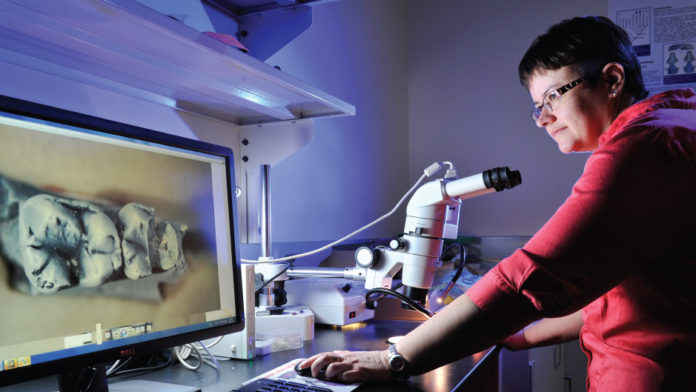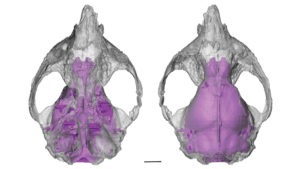“Some of them would have looked very squirrel-like,” explained Dr. Mary Silcox, a vertebrate paleontologist at the Department of Anthropology at the University of Toronto Scarborough.
That might not be the first way you want your ancient relatives described.
“Others would have probably looked a bit more primate-like, but they probably would have looked like wall-eyed primates,” she said, pausing to chuckle at these descriptions of a group of now-extinct mammals called plesiadapiforms. She and her team study them in order to shed light on the early evolution of primates, including humans.
Plesiadapiforms, these squirrel-looking, wall-eyed mammals, lived quite successfully in the Paleocene to the Eocene, just after dinosaurs went extinct, radiating into over 140 named species. The oldest known plesiadapiform, Purgatorius, dates back to about 65 million years ago. Fossils of plesiadapiforms are found as far north as Ellesmere Island, as well as from Europe and Asia, but Silcox’s team largely focuses on fossils from the Bighorn Basin in Wyoming and the Crazy Mountains Basin in Montana.
Basin living
“In the Bighorn Basin we have what is called layer-cake stratigraphy, so you can study change through time in a very real way,” said Silcox.
The Bighorn Basin has been a significant site for finding early mammal fossils since Jacob Wortman first excavated there in 1880. It’s an exciting place to be digging if you want to understand the process of evolution.
“We can see species A, an intermediate, and then species B, so you can actually document evolution happening, which is an extraordinary thing,” Silcox added, excitedly. But the basin might be a little less exciting for life prospects today.
“It’s badlands,” Silcox described. “It’s like sandy desert. It’s very arid.” There is not a lot of vegetation, except for cacti and sagebrush. “You get nostalgic for the smell of sagebrush,” Silcox reminisced. But as she also pointed out, it’s not the kind of thing you want to eat.
“It’s not a place that any reasonable primate would want to be, including us, to be frank. It’s challenging; the water sucks right out of your body. You have to constantly be drinking water. Primates live in forests with fruit. They don’t live in places like this.”
“But we love it out there!” she added about the fieldwork.
In the Eocene, Bighorn Basin would have been different. It would have been subtropical. The spot where Silcox and her team excavate was a flood plain traced by streams. There would have been trees with plenty of fruit. “Lots of the things that made primates happy,” Silcox explained. So plesiadapiforms probably lived like many modern primates: in the trees, eating fruits and bugs. These lifestyles may have led to typical features of modern primates, including arboreal locomotion, colour vision, and accompanying large brains.
Primitive Primates
In many ways, however, plesiadapiforms were more primitive. They were probably bounding on all fours rather than leaping with two limbs, like lemurs, through the canopy. They were generally small; the largest weighed about six pounds, while the smallest weighed one third of the smallest modern primate — that’s about 10 paper clips. With large front teeth and with eyes on the sides of their heads, rather than front, they wouldn’t exactly look like familiar chimpanzees, gorillas, or even smaller tarsiers. They would have looked more like rodents.
“This has led to a debate about what they are,” explained Silcox.
No matter what they look like, they might just be our primitive primate relatives, something Silcox has been researching since her PhD. As primitive primates, they would let us glimpse into our evolutionary past.
“One of the big set of holes in our understanding is why primates form this unique, distinct group that has its own features,” explained Silcox. To understand how this unique, distinct group arose, scientists like Silcox study primitive primates, such as plesiadapiforms. And many scientists are especially curious about one distinct feature of primates: increased brain size.
Ancient Brains + Cutting-edge Technology
We don’t know exactly why bigger brains in primates came about. Was it because we started living in forest canopies? Previously, it was thought that these evolutionary transitions, scampering in trees and bigger brains, happened as a package. But this might not be the case with plesiadapiform brains.
Brains don’t usually fossilize, so how do you study them in the fossil record? The answer is in new technology that Silcox’s team uses to make virtual endocasts, or 3D computer-generated images of the inside of both fossil and modern skulls. Silcox and her team use an industrial CAT scanner with a much higher resolution than those available in hospitals in order to get very fine resolution data about the size and shape of the inside of skulls.
“Basically, you have a series of images that look like cross-sections through the skull,” Silcox said, describing the process of constructing a virtual endocast. “At the resolutions we are scanning, you’ll typically get hundreds of them. So, the endcast will occupy somewhere around 800-1,000 slices. For each one of those slices, we have to go through and select the area where the brain would have been and essentially colour it a different colour. Then we take all of those and stack them together.” From the stack, Silcox’s team gets something that looks a lot like a brain.
Bottom (L) and top (R) views of a virtual endocast (purple) for the plesiadapiform Ignacius graybullianus inside a rendering of the cranium. The endocast was reconstructed by Silcox’s team from ultra high resolution X-ray computed tomography data collected from a nearly complete fossil dating to the early Eocene and collected in Clark’s Fork Basin, Wyoming. Further information can be found here.
“It’s pretty time-consuming, particularly if you are studying fossils,” explained Silcox. “Fossils are a bit more challenging because they are not hollow inside.”
Silcox’s students laboriously learn to differentiate between fossilized skull and rock. It took the hard work of an undergraduate student a year and a half to produce the first, detailed endocast, which the team published in 2009. But they are getting faster: the second endocast took six weeks, and now, a graduate student in the lab can do one of a modern skull in as little as two hours. What’s more, now Silcox’s team can 3D print the endocasts, which helps researchers analyze them.
“And it’s also just super-duper cool!” exclaimed Silcox.
Super-duper cool small brains
The plesiadapiforms have simple, small brains, explained Silcox: “They don’t look like a human brain with all the complicated infoldings that you can use as landmarks to neurofunctional regions. These brains are almost entirely smooth; there is maybe one indentation to increase their surface area.” As a result, Silcox explained further, it is challenging to make strong claims about functional changes and resulting behavior.
But the small size is significant.
“The extraordinary thing to realize is that these animals — their brains are between maybe a quarter to half the size of a living primate of a similar body mass, and yet they were living lives that were really not that different,” said Silcox.
So Silcox and her team are challenging the claim that bigger brains were packaged with primate lifestyles of scampering about in trees eating fruit. The transition to bigger brains didn’t start right when primates branched off, but later.
Maybe brains got bigger for better visual processing or for increased social relations, Silcox conjectured. She pointed out that knowing more accurately when brain size increased would allow researchers to start considering these conjectures, which they don’t yet know for certain. What we do we know?
“We know that mammals do a lot with not that much brain power,” and she chuckled.










































